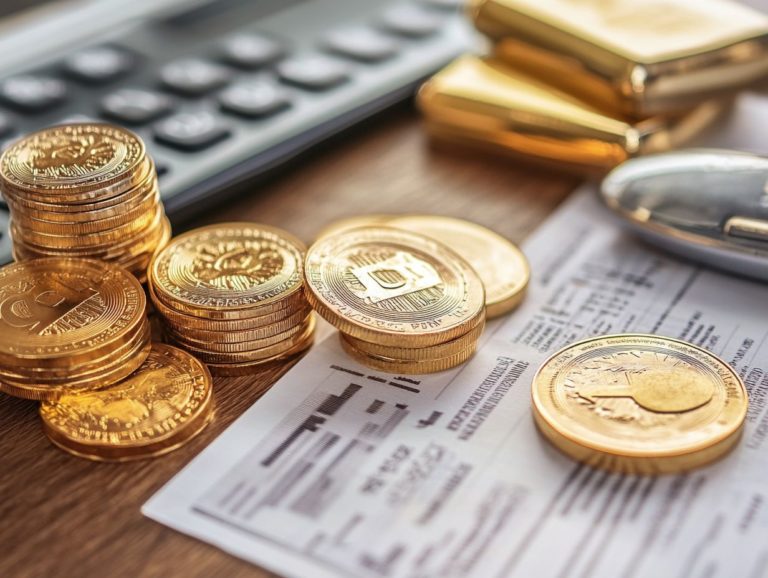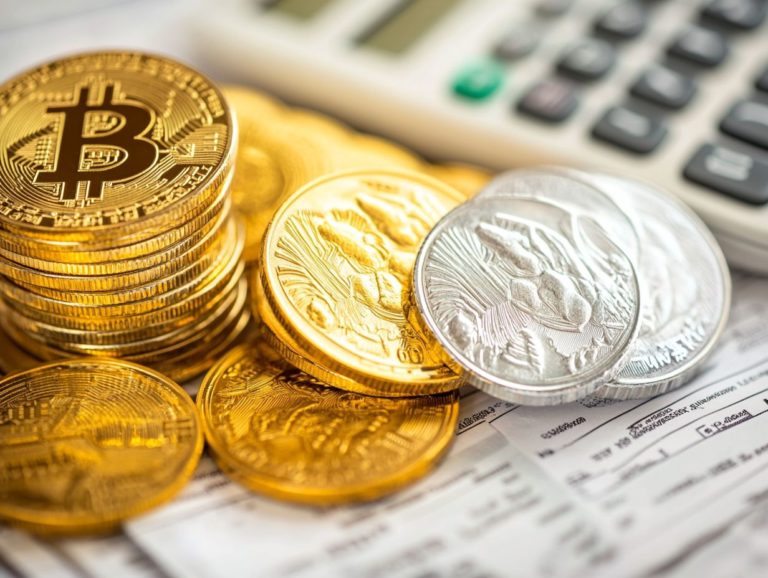The Importance of Tax Planning for Precious Metals Investors
Navigating the realm of precious metals investment can be rewarding and intricate, especially when it comes to tax planning. Understanding how taxes impact your investments is crucial for maximizing profits and minimizing liabilities.
This article explains tax planning for precious metals investors, detailing the implications of capital gains tax, alternative minimum tax, and the necessary reporting requirements. It outlines effective strategies to reduce your taxes. Consulting a tax professional is also essential.
Whether you re a seasoned investor or just beginning your journey, these insights will empower you to make informed decisions about your precious metals portfolio.
Contents
- Key Takeaways:
- Understanding Tax Planning for Precious Metals Investors
- Tax Implications of Investing in Precious Metals
- Strategies for Minimizing Taxes on Precious Metals Investments
- Working with a Tax Professional
- Frequently Asked Questions
- What are the benefits of long-term holding?
- How can I offset my capital gains?
- Why should I consider retirement accounts for my investments?
- What is tax planning and why is it important for precious metals investors?
- What are some tax benefits for precious metals investors?
- How can proper tax planning help protect my investments?
- What are some common tax mistakes made by precious metals investors?
- Can tax planning help me diversify my precious metals portfolio?
- Are there any specific tax laws or regulations that apply to precious metals investors?
Key Takeaways:
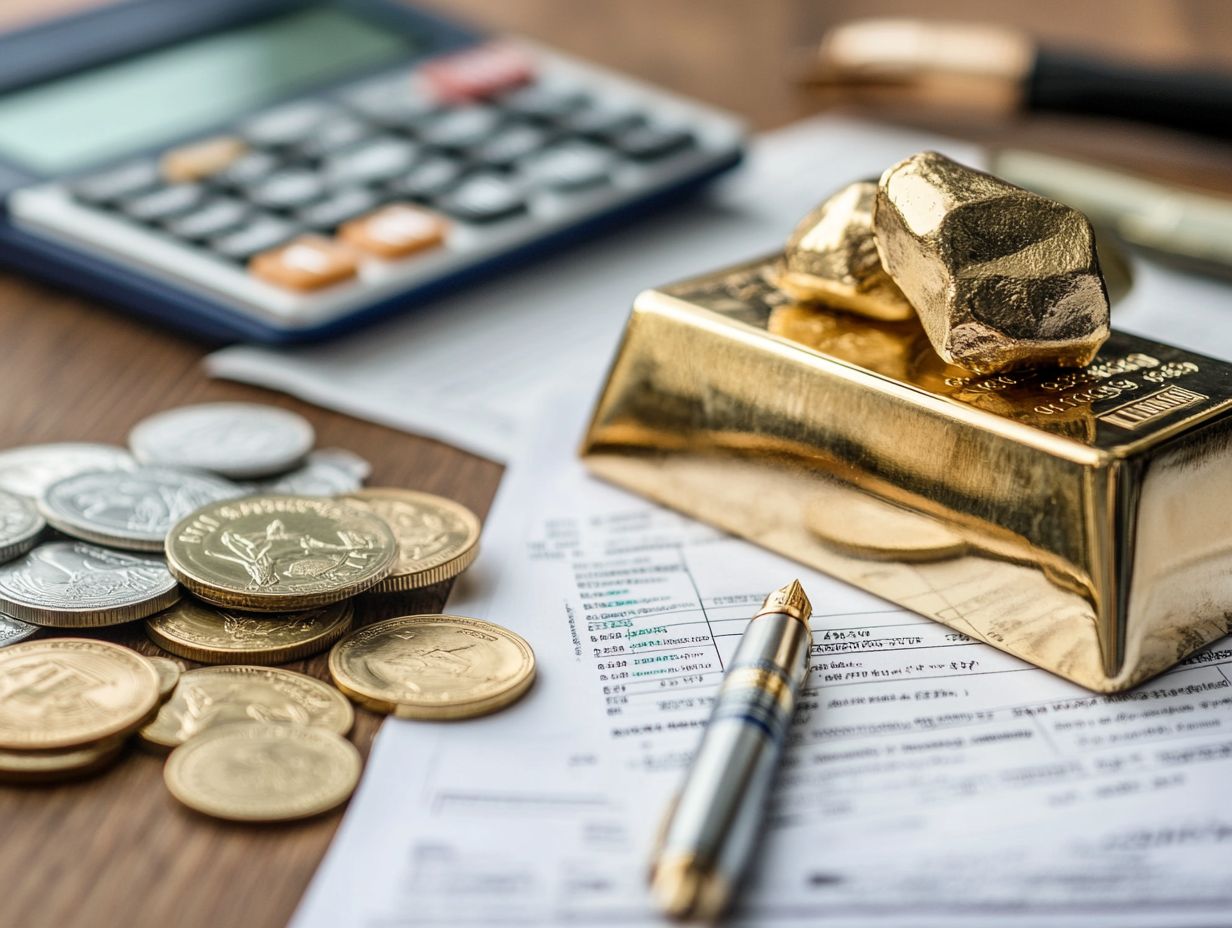
- Proper tax planning is crucial for precious metals investors to minimize tax implications and maximize returns.
- Be aware of capital gains tax and alternative minimum tax when investing.
- Strategies like holding periods and utilizing retirement accounts can help reduce taxes.
Understanding Tax Planning for Precious Metals Investors
Tax planning for precious metals investors requires a nuanced understanding of various financial strategies that enhance returns while minimizing tax liabilities. This means being well-versed in current tax laws and reporting requirements. It’s also important to understand how different investment vehicles like physical metals, ETFs, and mutual funds interact with capital gains and ordinary income tax.
As an investor in precious metals like gold, silver, and platinum, don’t overlook estate planning; it’s vital for protecting your investments. Contemplating asset protection strategies ensures compliance with federal regulations and enables you to leverage the tax impact of precious metals to their fullest potential.
What is Tax Planning?
Tax planning involves analyzing your financial situation to maximize tax efficiency and minimize liabilities, all while ensuring compliance with current tax laws. For you as an investor in precious metals, effective tax planning is especially essential, as the intricate details of these investments can greatly influence your overall tax liability.
Start by assessing your current portfolio to identify which assets qualify for favorable tax treatments, such as long-term capital gains rates. Consider implementing strategies like tax-loss harvesting, which allows you to offset gains with losses, ultimately reducing your overall tax burden. Staying informed about available tax deductions related to your investment activities is also crucial, as these can lead to additional savings.
By thoughtfully incorporating tax planning into your investment strategy, you can significantly enhance your financial growth while understanding tax rules.
Why is it Important for Precious Metals Investors?
Understanding the significance of tax planning is essential for you as a precious metals investor, as it directly impacts your investment returns, tax implications, and overall financial growth.
Each type of precious metal carries its own distinct tax rules and regulations, which can greatly influence your net profits. For example, capital gains tax rates can vary depending on whether you’re dealing with gold, silver, or platinum. Typically, gold and silver benefit from favorable long-term capital gains treatment, while collectibles, like certain forms of platinum, may attract higher tax rates. Understanding the importance of tax compliance for precious metals investors is crucial for optimizing your investment strategy.
By recognizing these nuances, you can implement tailored strategies that optimize your tax savings. Smart planning might involve timing the sale of your assets to align with lower income years or leveraging tax-advantaged accounts, enabling you to navigate tax rules while maximizing your returns.
Tax Implications of Investing in Precious Metals
When you invest in precious metals, it s essential to understand the specific tax implications involved to ensure compliance and minimize your tax liability. These considerations include factors such as capital gains tax, which applies to the profits you make from selling precious metals like gold, silver, and platinum.
It s vital to understand the IRS reporting requirements, including the necessity of filing Form 1099-B. Knowing these rules helps you avoid costly mistakes down the line and is crucial for maintaining accurate records.
Capital Gains Tax
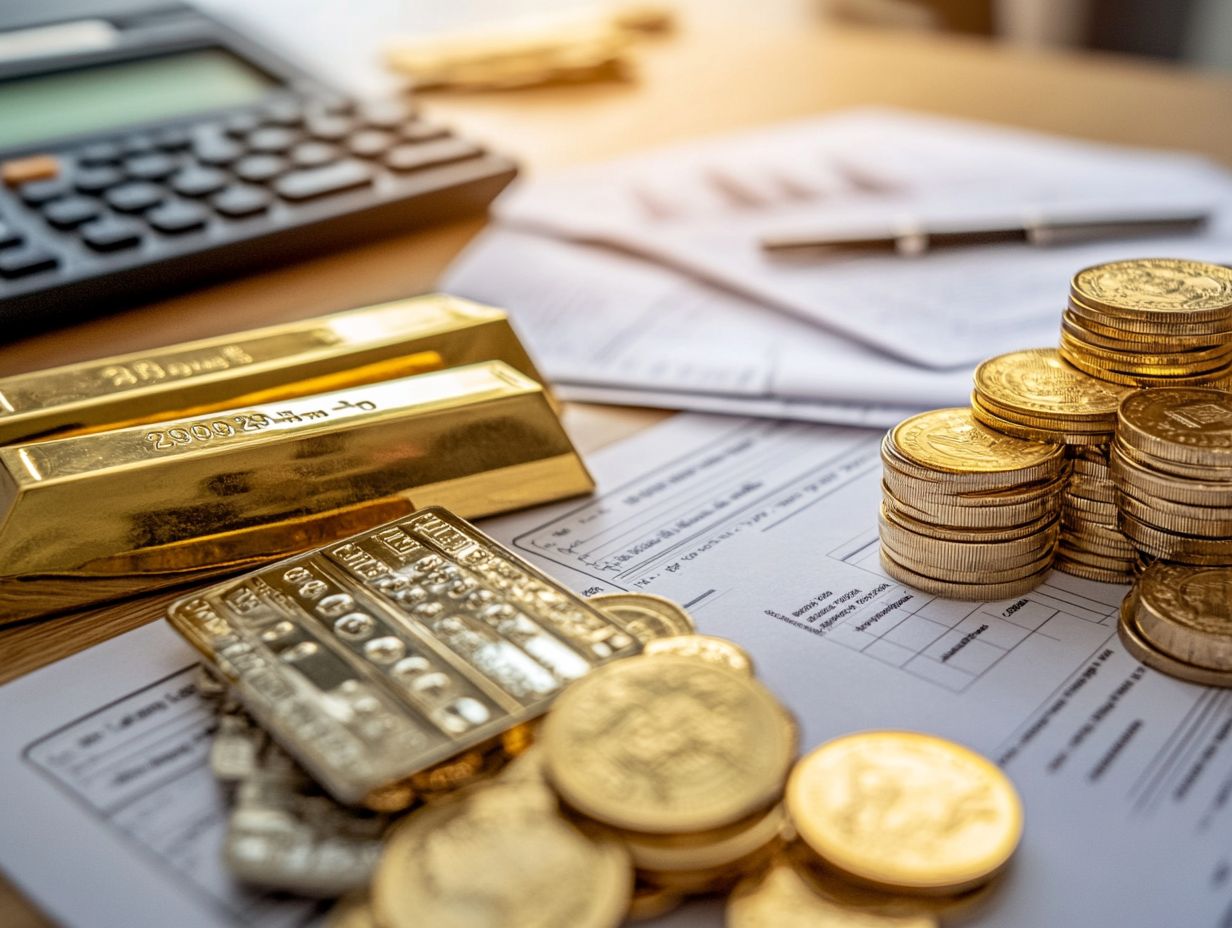
Capital gains tax is a critical factor for you as an investor in precious metals, applying to the profits you earn when selling assets like gold, silver, and platinum.
If you’ve held your assets for less than a year, you ll face short-term capital gains. These are taxed at the higher ordinary income tax rate, which can significantly elevate your tax liabilities.
On the flip side, long-term capital gains, which apply to assets held for over a year, are subject to lower rates. This underscores the importance of your holding periods in your tax planning.
To navigate this landscape effectively, it’s essential for you to maintain careful records of your acquisitions, sales, and valuations. This diligence not only aids in accurately reporting gains but also helps minimize your tax burdens, ensuring you are well-prepared for any potential tax implications that may arise from your investment choices.
Alternative Minimum Tax
Understanding the alternative minimum tax (AMT) is crucial for you as a precious metals investor, as it can significantly impact your overall tax burden and financial growth.
This tax mechanism ensures that even those who take advantage of various deductions contribute a minimum level of tax. If you’re in the precious metals market, you might find yourself facing higher taxes than anticipated, particularly when gains from metals like gold or silver elevate your income beyond certain thresholds. For a deeper understanding, consider exploring the tax responsibilities of precious metals investors.
You could encounter AMT challenges if you sell your holdings for substantial profits or accumulate significant capital gains. To navigate these complexities, consider strategies like tax-loss harvesting, diversifying your investments, and consulting with tax professionals to reduce your AMT exposure and maximize returns.
Reporting Requirements
As a precious metals investor, you must adhere to specific reporting requirements set forth by the IRS to ensure tax compliance and avoid any potential penalties.
This includes the necessity of filing Form 1099-B for any transactions involving the sale or exchange of precious metals. This form is crucial, as it reports the proceeds from such transactions, keeping the IRS informed about your earnings.
Accurate record-keeping is essential in this process. Not only does it help you track capital gains and losses, but it also streamlines the filing process, reducing the risk of errors that could trigger audits or additional scrutiny.
By maintaining detailed records, you can navigate tax planning more effectively, enabling you to make informed decisions that align with your financial goals.
Strategies for Minimizing Taxes on Precious Metals Investments
Minimizing taxes on precious metals investments necessitates a thoughtful approach and the implementation of various strategies designed to enhance tax savings while reducing liabilities. You can adopt techniques like tax-loss harvesting and utilize diverse investment vehicles, such as self-directed IRAs and tax-advantaged accounts, to refine your tax position.
By familiarizing yourself with holding periods and relevant tax rates, you can considerably lessen your tax burden while ensuring compliance with IRS regulations.
Ready to optimize your precious metals investments? Start tracking your records today!
Holding Periods and Tax Rates
Understanding the relationship between holding periods and tax rates is crucial for you as an investor in precious metals. This knowledge allows you to optimize your investment strategies.
By grasping the nuances of long-term versus short-term holding periods, you can significantly impact your potential return on investment. It also affects the tax you owe on profits tied to those investments. Assets held for more than a year are subject to lower long-term capital gains tax rates, often leading to a more favorable financial outcome.
If you foresee needing cash in the short term, you might opt to sell sooner, accepting the higher short-term rates for quick access to money. Positioning your investments for the long term can reduce tax burdens and enhance your net gains, ultimately fostering financial growth when approached strategically.
Offsetting Losses with Gains
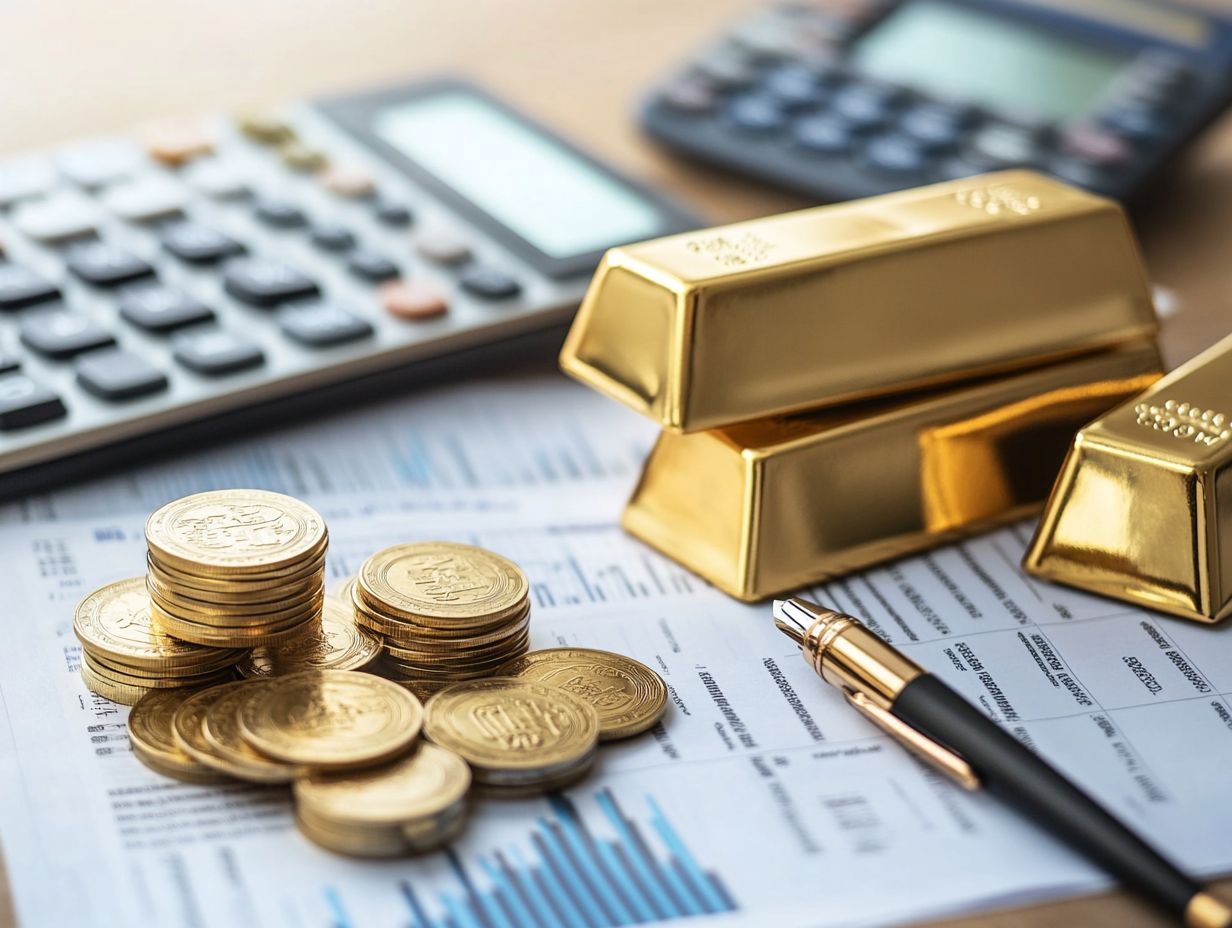
Offsetting losses with gains is an essential strategy for you as a precious metals investor. This approach helps you manage tax liabilities effectively.
It not only alleviates your tax burden but also enables you to optimize your portfolio through strategic transaction planning. By recognizing that capital losses can offset capital gains, you can reduce the tax impact from your profitable sales.
Knowing tax policies can empower your investment decisions! Staying updated on regulations ensures you can capitalize on tax benefits while avoiding potential pitfalls.
Utilizing Retirement Accounts
Don t miss out on valuable tax advantages utilize retirement accounts like self-directed IRAs and Roth IRAs today! These accounts offer you valuable tax advantages that can elevate your investment strategy in precious metals.
They not only enable you to diversify your portfolio with gold and silver but also allow you to defer taxes on the growth of these assets until retirement. This tax-deferred growth can significantly amplify your long-term financial gains.
Self-directed accounts typically come with flexible compliance requirements. This flexibility makes it easier for you to align your investments with your personal financial goals.
By strategically leveraging these retirement accounts, you can pave the way for a more secure financial future, laying the groundwork for wealth accumulation in the years ahead.
Working with a Tax Professional
Engaging with a tax professional is an invaluable asset for precious metals investors. Their expertise in tax planning and IRS compliance can profoundly influence your financial growth.
A seasoned financial professional will guide you through the intricate landscape of tax implications. They will pinpoint potential tax-saving strategies and ensure that you stay compliant with current tax laws.
This partnership not only enhances your investment strategy but also fortifies your financial future.
Benefits of Seeking Professional Advice
Seeking professional advice from a tax expert can offer substantial advantages for precious metals investors. This expertise enhances both your tax compliance and financial growth.
Such guidance provides you with tailored tax strategies that align perfectly with your unique financial situation. It significantly reduces the risk of complications during IRS audits.
By grasping the nuances that could affect your investments, you can optimize your tax liabilities. Ultimately, this partnership encourages smarter choices, helping you build and sustain wealth over the long term.
Frequently Asked Questions
What are the benefits of long-term holding?
Long-term holding can lead to lower tax rates and greater investment growth.
How can I offset my capital gains?
You can offset gains by utilizing capital losses from other investments.
Why should I consider retirement accounts for my investments?
Retirement accounts provide tax advantages and help in deferring taxes until retirement.
What is tax planning and why is it important for precious metals investors?

Tax planning is about planning your finances to minimize taxes. This strategy maximizes your tax benefits, which is vital for precious metals investors.
What are some tax benefits for precious metals investors?
Investors can enjoy benefits, like lower taxes on profits held long-term and tax-free exchanges. These advantages help boost your returns.
How can proper tax planning help protect my investments?
Effective tax planning reduces your tax burden. This means more money for reinvesting or protecting against losses.
What are some common tax mistakes made by precious metals investors?
Common mistakes include not reporting gains, missing out on deductions, and misclassifying investments. Avoid these errors to save money!
Can tax planning help me diversify my precious metals portfolio?
Yes! Tax planning allows you to take advantage of different tax rates, which can reduce risk and increase profitability.
Are there any specific tax laws or regulations that apply to precious metals investors?
Absolutely! Laws like the wash sale rule and the collectibles tax rate specifically affect precious metals investments. Be informed to avoid costly mistakes!










